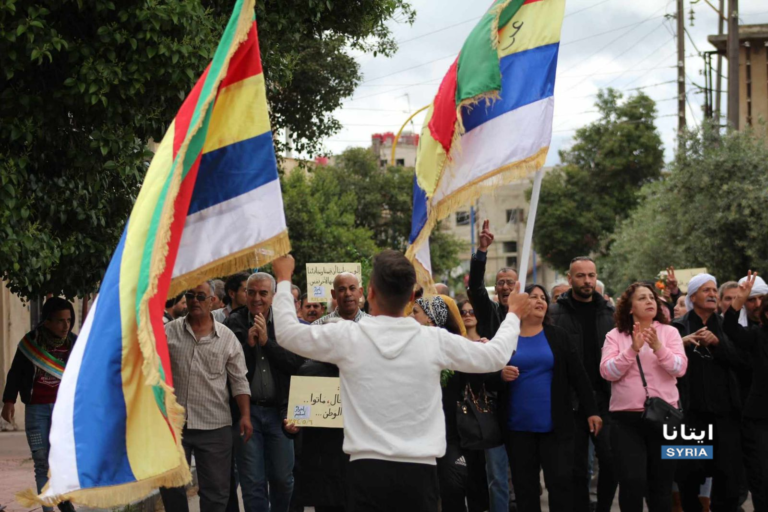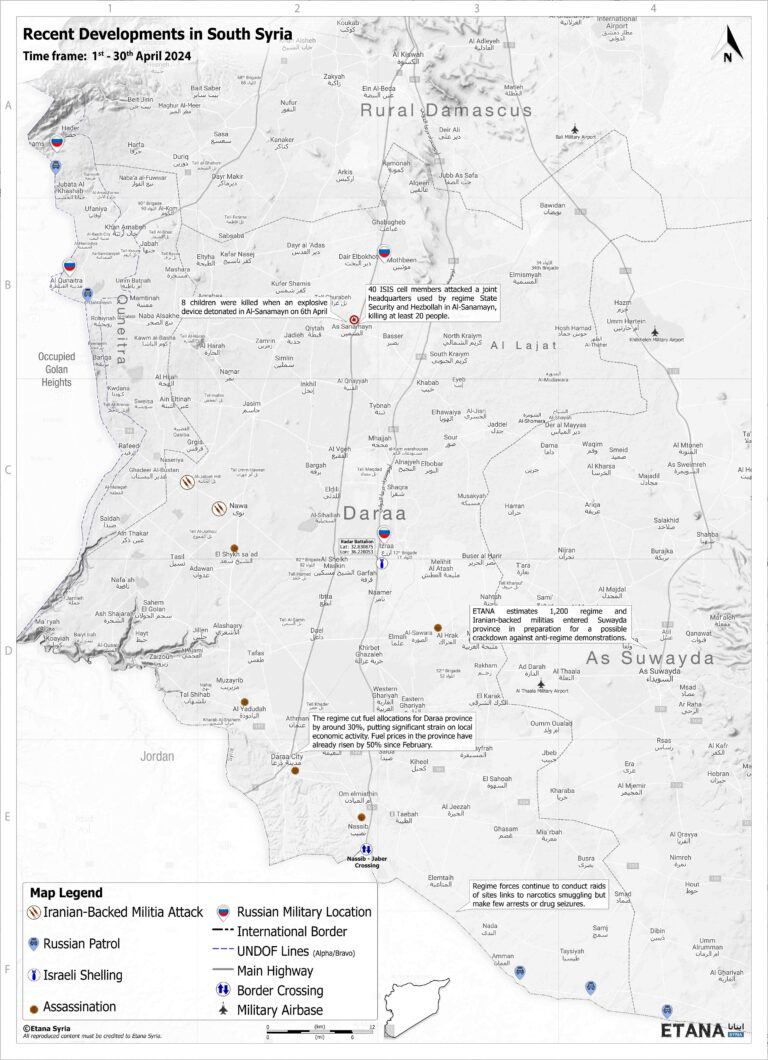Regime and Iranian-backed militia deployments to Suwayda province raised fears of a violent crackdown on ongoing anti-regime protests. So far, mediations between the regime and influential Druze community leaders have kept the situation from escalating, but local armed groups are still preparing for the possibility of an armed confrontation.
In Daraa, clashes lasting six hours broke out in Al-Sanamayn after an ISIS cell attacked a joint headquarters used by regime forces and Hezbollah. At least 20 people, many of them civilians, were killed. The battle between local extremist groups on one side, and Hezbollah and regime intelligence on the other, has grown into one of the most intense unresolved feuds currently taking place in Daraa province.
Meanwhile, there has been a marked decline in attacks targeting Israel and the occupied Golan Heights by Iranian-backed militias based in south-west Syria, although Israeli forces have continued to target regime and Iranian sites with airstrikes and artillery fire.
Extremist Activity
Around 40 ISIS cell members attacked a joint headquarters used by regime State Security and Hezbollah in the northern Daraa city of Al-Sanamayn. The resulting clashes, which lasted for six hours, killed at least 20 people, including many civilians. This violent and unresolved conflict between the two sides has been ongoing since February, cumulatively causing more than 40 deaths and making them among the most intense cycles of violence currently taking place in Daraa province. The violence in Al-Sanamayn represents but a microcosm of the destabilizing dynamics in south-west Syria, where former opposition groups, ISIS cells and regime forces all compete for influence and control.
Regime Activity
Regime forces conducted regular raids of farmhouses in eastern and southern Daraa under the pretext of counter-narcotics operations, although most led to no arrests or drug seizures. Many of the regime’s counter-smuggling operations for the past year have been similarly performative, likely to appease neighboring states who normalized with Syria on the condition of collaborating on border security efforts.
Suwayda Protests
In late April, regime and Iranian-backed militias started sending a concerning number of military reinforcements to Suwayda province. ETANA assesses that, by 30th April, around 1,200 regime troops and militia fighters were sent to Suwayda. Notably, these included members of the regime’s Republican Guard, Air Force Intelligence and Military Intelligence. These are unusual deployments suggesting that the regime did—or does still—plan some form of violent crackdown in Suwayda. Notably, Iran’s Islamic Revolutionary Guard Corps (IRGC) and Quds Force fighters were also part of the deployments.
Senior Druze community figures have engaged with regime representatives in ongoing efforts to avoid escalation, but regime fighters were seen patrolling Suwayda city in a blatant attempt at intimidation. Despite their presence, ETANA estimates that more than 2,500 protesters rallied in Suwayda the following Friday—the largest demonstration the province has seen in months.
Peaceful anti-regime demonstrations have been going on in Suwayda for almost a year now, but local backlash over the arrest of a university student prompted the strong regime response. In early February, Tishreen University student Danny Obaid was arrested after sharing a Facebook post in support of the Suwayda protests. After Obaid’s father failed to secure his son’s release through legal channels, local armed groups in Suwayda kidnapped several regime officers in hopes of securing a prisoner swap.
Obaid was released on 29th April, but tensions remain high in the province. Many local armed groups have been preparing for the possibility of an armed confrontation with regime forces. Influential local cleric Sheikh Hikmat al-Hijri released a statement on the day of Obaid’s release, warning Damascus not to escalate.
Conflict with Israel
Despite the decline in attacks from Iranian-backed militias in the south, Israel has continued to target Iranian and regime sites with airstrikes and artillery fire. No casualties have been reported.
Instability in South Syria
The number of armed attacks against regime forces has continued to rise, with the road between eastern Daraa and western Suwayda becoming a notable hotspot for ambushes and clashes with militant groups. In total, eight attacks last month claimed the lives of at least three soldiers and seriously wounded several others. Notable community figures and ordinary civilians also continue to be frequently targeted by assassinations across south Syria, with recent weeks seeing a total of 17 assassinations. Among those killed were drug traffickers, family members of former opposition leaders, civilians, extremist group members and regime officers.
Humanitarian Developments
Between a dwindling economy and an unending spiral of violence, the humanitarian situation in south Syria remains extremely dire. Last month, the regime reduced fuel allocations for Daraa province by around 30%, putting significant strain on a range of local industrial and economic activity. The province has witnessed sharp surges in fuel prices recently: the price of 90-octane gasoline rose 50% to 12,000 Syrian pounds since February while 95-octane gasoline was priced at 14,870 SYP and diesel at 12,425 SYP at the end of April.
As a result, many young people continue to leave in large numbers in hopes of reaching Europe. Nine young men from south Syria drowned when a migrant boat from the Libyan coast capsized while en route to Italy on 14th April. Over 5,000 young men from south Syria are currently in Libya awaiting boats to smuggle them to southern Europe.
Civilians continue to face risks in their communities across the south. Eight children were killed when an explosive device detonated in Al-Sanamayn on 6th April. Such incidents are expected to continue, with mine blasts and explosions of left-over ordnance routinely maiming and killing civilians across south Syria. Several similar casualties were reported in the eastern Daraa countryside in April.







